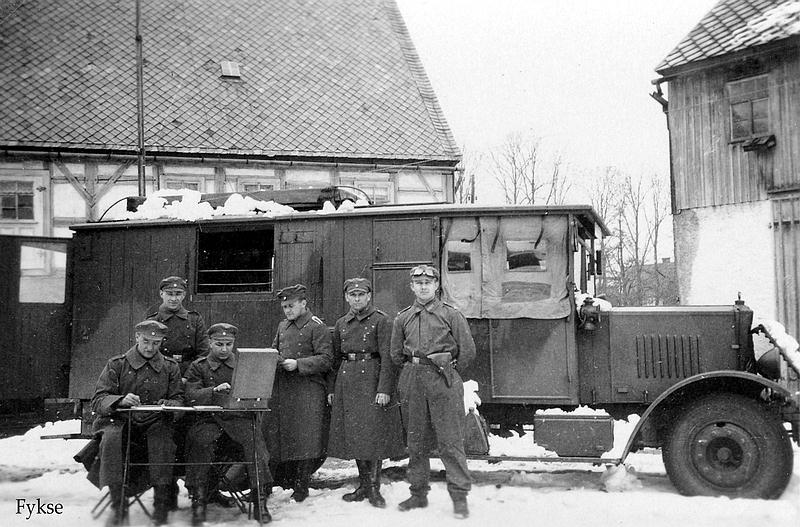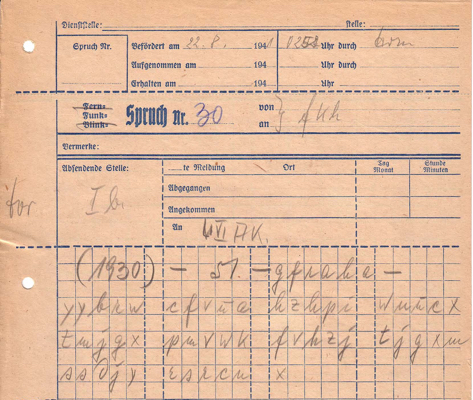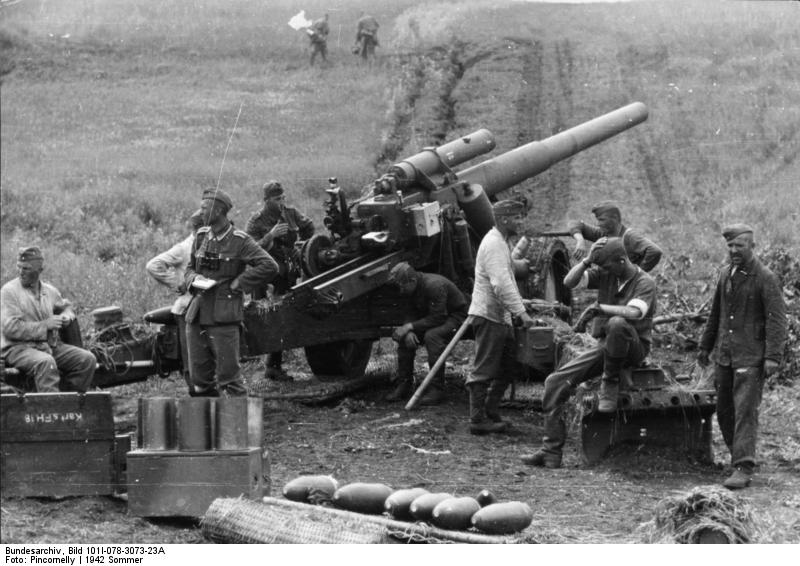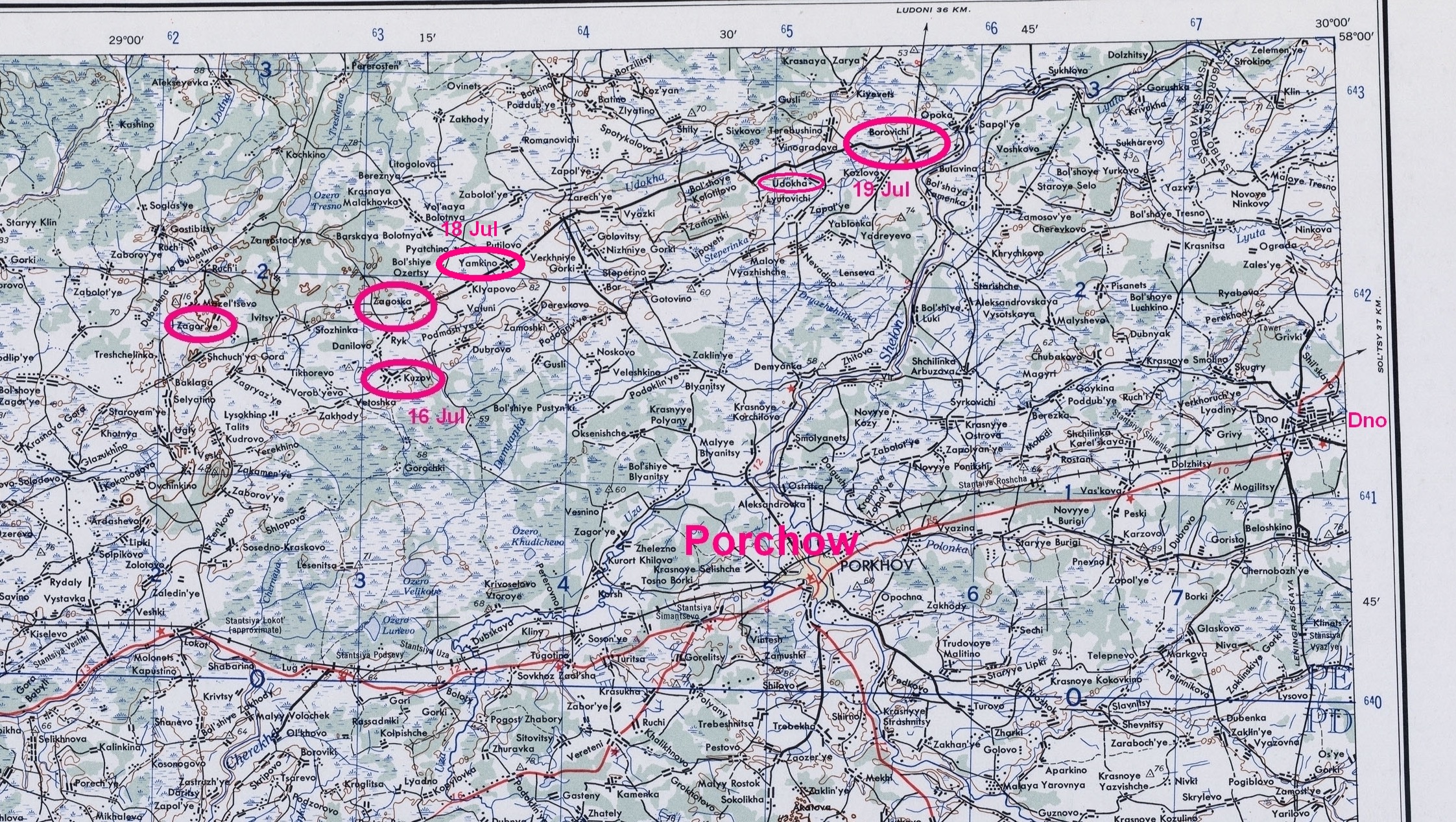
German motorised radio unit operating under winter conditions.
Photo: With permission of Helge Fykse, LA6NCA, Norway © 2016
This Web page contains information and documents that are related to our article “Modern breaking of Enigma ciphertexts” by Olaf Ostwald and Frode Weierud and that was published in Cryptologia Volume 41, Issue 5, pages 395‐421. The author’s version is available here.
For additional information, the ciphertexts of all authentic messages mentioned in our article are listed here in their order of appearance in the article. The original ciphertexts from the scans of the authentic message forms have been transcribed by the authors, and are given together with the recovered keys. Any suitable Enigma simulator, e.g. the one by Dirk Rijmenants (Enigma Simulator) can be used to decipher the texts. Hereby it should be observed that the first 5-letter group is the discriminant (Kenngruppe) and not part of the ciphertext. Thus the deciphering always starts with the second group.
Taking the first message FHPQX as an example, the first letters of the ciphertext are FDZCJ. Before it may be entered into the simulator (or a real Enigma) the cipher machine has to be set to the correct key. The key here is given with a first group (e.g. ‘B423’) for the rotor set, indicating the reflector B, and the three rotating wheels, to be inserted from left to right (here using Roman numbers instead of the Arabic 423) wheel IV as the left-hand wheel, wheel II as the middle wheel, and wheel III as the right-hand wheel. The second group (here ‘gto’) indicates the ring setting (Ringstellung) for the three rotors. Some machines do not use letters for the rings, but numbers instead. Here ‘a’ corresponds to ‘1’, ‘b’ to ‘2’, ‘c’ to ‘3’, and so on until ‘z’ to ‘26’. So, ‘gto’ can be substituted by ‘07 20 15’.
Then the start position (here ‘SDV’) for the three rotors is given, which afterwards can be checked through the windows of the Enigma. Again, some machines here use numbers instead of letters. And again the same relation is valid, namely ‘A’ corresponds to ‘1’, ‘B’ to ‘2’, ‘C’ to ‘3’, and so on until ‘Z’ to ‘26’. Instead of ‘SDV’ then ‘19 04 22’ is the start position. Finally, the ten plugs (Stecker) are defined, here starting with the plug AD (meaning a cross-over plug between the letters A and D), then EH and so on, until at last the plug UW. Now the ciphertext, beginning with FDZCJ can be entered, and the plaintext lights up, starting with ANXPA, the first letters of “An Panz. Gruppe Vier” (To Tank Group 4).
The message forms (Spruchzettel) are used for both incoming and outgoing messages. To easily distinguish the two types of messages the radio operators used red and blue colour pencils to write the message serial number. Red was used for incoming messages and blue for outgoing messages. The two types can also be identified by looking at which field the radio operator wrote the date and time. If it is written in the Sent (Befördert) field it is outgoing and if it is written in the Received (Aufgenommen) field it is incoming.
Two of the messages, No. 30 of 22 August 1941 and No. 233 of 19 July 1941, are somewhat special because they were created and enciphered on 21st August and 18th July, and not the day when the messages were sent. The reason for this delay in transmission is not known, but some possible reasons are given below. As can be seen from the message form for the message of 22nd August it was prepared and enciphered at 1930 on the 21st August, using the Enigma key of this day, while it was transmitted first at 0252 on the 22nd. The message of 19th July was created and enciphered at 2300 on the 18th July, again enciphered with the key of the 18th, while it was received first at 0220 on the 19th. This situation would happen from time to time at the end of a day when messages were prepared close to or just before the daily change of the Enigma keys. Normally the messages were transmitted shortly after they were created, usually within an hour and sometimes within only 10 minutes. But a delay of seven and a half hours such as for the message of 22nd August 1941, is rather rare.
There can be many reasons for this such as poor radio conditions, the need for retransmission via a relay station or simply that the receiving station was not operational. At the front many of the stations were mobile radio units (Funkkraftwagen) and the larger units were usually not able to handle traffic during transit as they were dependent on generator power and the use of field erectable antennas. Normally the mobile radio vans were equipped with two Enigma machines. At the daily change of the Enigma key one machine would then be kept on the old key while the other machine would be set up for the new key. This way the stations could still easily handle delayed traffic. Later in the day both machines would be set to the daily key or in some cases one machine would be set up with a secondary key for handling traffic on a different cipher network, such as the key for cross network traffic (Querverkehr-Maschinenschlüssel). The medium motorised radio units (mittlere Funktrupps (mot)) and the large motorised radio units (große Funktrupps (mot)) were both equipped with two Enigma machines, while the more specialised motorised cipher units (Schlüsseltrupps (mot)) had four Enigma machines.

German motorised radio unit operating under winter conditions.
Photo: With permission of Helge Fykse, LA6NCA, Norway © 2016
The radio van shown in the photo above is most likely of the type Funkkraftwagen 61, medium motorised radio unit (mittlerer Funktrupp (mot) mit Funkkraftwagen (Kfz. 61))
Errors and typos are unfortunately also present in this article.
… ring settings for the middle and left-hand wheels are possible.
… ring settings for the middle and right-hand wheels are possible.
BP first broke this key on 2 February 1942 …
… broke this key on 2 January 1942 …
… (“non-crashing” rule; Sullivan and Weierud 2005, p. 204).
… (“non-clashing” rule; Sullivan and Weierud 2005, p. 204).
A rule or principle not permitting, or tending to avoid, the same position for the same wheel on consecutive days.On the other hand, the term “non-crashing” is defined as:
A characteristic of cipher text in which a cipher letter cannot equal the same plain letter.This is the property of a cipher like the Enigma where a letter cannot encipher to itself.
Descriptive Dictionary of Cryptologic Terms: Including Foreign Terms,United States, Army Security Agency, 1946.
The authors’ copy of the article has been updated with corrections to these errors. Latest version is: Version 5, March 2017.
The 13 messages used for our article are reproduced in
the following format:
Message No. and the date of transmission or reception
Key with wheel order, ring setting, initial position, and plugs
Discriminant Ciphertext
Raw plaintext
Transcribed plaintext including garbles
Emended plaintext
Translated plaintext
Facsimile of outgoing message No. 25 of 13 July 1941
Message No. 25 of 13 July 1941
B423 gto SDV AD EH GY IM KN LR OZ QV TX UW
FHPQX FDZCJ JDKVW PYFDW
POQZG TJQYY XAFRH SQESE
RKGJB WBYPE OOKFM MPOMK
QDDOL CPKHY PGUZY XBZYA
NYSAX IPXVQ CPJBF FFDRD
XFIJJ PPPEY ALCYK VLKXQ
HWIRZ ANGWU JBWVJ YCKES
MJQRY KQHCQ OKMMY WMCKV
LZJDV ZXRUM RMNWF DZBQG
XJQAP FFFZT AHJQZ PWQWN
IVZWU IJTHO YXGDC OJUW
ANXPA NZXGR UPPEX
VIERX SIEGF RIEDS IEGFR
IEDTO NIXDI VXSTE HTSEI
TXEIN SZWOX SIEBE NXEIN
SEINS NULLN ULLXU HRMIT
ANFAE NGENA MUNTE RKUNF
TSRAU MXKAN NNIQT EINFL
IESZE NXDAX DRITT EXINF
XDIVX UNDXA QTEXP ANZXD
IVXBL OQIER ENUND RANMB
ELEGT HALTE XDIVX KDRX
An x Panz x Gruppe x Vier x Siegfried Siegfried Toni x Div x steht
seit x Eins Zwo x Sieben x Eins Eins Null Null x Uhr mit Anfaengen
am Unterkunftsraum x Kann niqt einflieszen x da x dritte x Inf x
Div x und x Aqte x Panz x Div x bloqieren und Ranm belegt halte x Div x Kdr x
An x Panz x Gruppe x Vier x Siegfried Siegfried Toni x Div x steht
seit x Eins Zwo x Sieben x Eins Eins Null Null x Uhr mit Anfaengen
am Unterkunftsraum x Kann niqt einflieszen x da x dritte x Inf x
Div x und x Aqte x Panz x Div x bloqieren und Raum belegt halten x Div x Kdr x
To Tank Group 4: SST Div [SS Death’s Head Tank Division
(SS-Totenkopf-Panzerdivision)] stands since 12 July 1100 hours with vanguard
at the accommodation space. Cannot enter, as 3rd Inf Div and 8th Tank Div are
blocking and keeping place occupied. Div Cmdr.
Facsimile of incoming message No. 65 of 26 August 1941
Message No. 65 of 26 August 1941
B321 xbm DOF AE BT CF DK GJ HM IS LV OZ UX
EJRSB UNXXI SVILM HHKZP
JZU
TAGES MMLDU NGFUN
KEN
Tagesmmldung funken
Tagesmeldung funken
Send daily report by radio
Facsimile of incoming message No. 1 of 1 October 1941
Message No. 1 of 1 October 1941
B514 kbu DEI AG EL FN HU JV KM OP QR SW TX
PLVJH HBCZF WXKBE JDLUX
CODAA QV
MORGE NMELD UNGEN
TFAEL CT
Morgenmeldung entfaelct
Morgenmeldung entfaellt
Morning report cancelled
Facsimile of incoming message No. 2 of 1 October 1941
Message No. 2 of 1 October 1941
B514 kbu DEI AG EL FN HU JV KM OP QR SW TX
OSMRV JMYDK APZMJ LRHTO
VJTMP JZVA
ZWISN ENMEL DCNGE
NTFAE LLTX
Zwisnenmeldcng entfaellt x
Zwisqenmeldung entfaellt x
Intermediate report cancelled.
Facsimile of incoming message No. 128 of 8 July 1941
Message No. 128 of 8 July 1941
B432 pkf SWV CY EL FH GS IJ KQ MW PV RZ TU
TZLPT XPDBQ LJWFT ULSZC
DKQPS WIMGB YS
WOROE MEINS BERTA
STAFF ELFRA GE
Wo Roem Eins Berta Staffel Frage
Wo Roem Eins Berta Staffel Frage
Where [is] Roman One B squadron? [Ib is the Chief of Supply]
Facsimile of incoming message No. 71 of 27 August 1941
Message No. 71 of 27 August 1941
B132 les BEN AY BJ DG EH FQ IM KO LP NW RT
AMERI TDLYX LHUVK OGOTU
XNVRB PVICI BWTST YD
ZWOXS TAFDE LAMXZ
WOSIE BENXA QTXVI ER
Zwo x Stafdel am x Zwo Sieben x Aqt x Vier
Zwo x Staffel am x Zwo Sieben x Aqt x Vier
Second squadron on 27 Aug 4[1 (for 1941) and a possible rest is missing]
Note: The complete ciphertext has not been recorded on the message form
but the complete plaintext is given as:
Zwo x Staffel am x Zwo Sieben x Aqt x Vier Eins x Eins Neun Drei Null x in x
Wjelikoje x Wjelikoje x Striq x Sjelok x Sjelok untergezogen x Schoeffler x
Schoeffler
Second squadron on 27 Aug 41 [at] 1930 in Wjelikoje-Sjelok. Schoeffler.
Facsimile of outgoing message No. 15 of 2 September 1941
Message No. 15 of 2 September 1941
B432 rit VOR AH BO DP EX FN JQ KS LR MU TZ
PFCXY PSQDB CSFKH FJOMV
CJAUX TOTQB BPBWA CHZYX
H
ABEND MELDU NGENE
NTFAL LENXH ARTJE NSTEI
N
Abendmeldungen entfallen x Hartjenstein
Abendmeldungen entfallen x Hartjenstein
Evening reports cancelled. Hartjenstein
[Friedrich Hartjenstein, born 3 July 1905, was Hauptsturmführer (Captain)
of the SS at that time (1941). In 1942 he became Obersturmbannführer
(Lt. Colonel) and was appointed the commandant of Nazi concentration camp
Auschwitz-Birkenau, and in 1944 of Natzweiler concentration camp in France.
After the war, he was tried for war crimes and found guilty for murder and
crimes against humanity. He died of a heart attack on 20 October 1954 in
Paris while awaiting his execution.]

Message No. 30 of 22 August 1941 is somewhat special because it has been enciphered with the daily Enigma key of 21 August 1941 and not the one for 22nd August, when the message was sent. As can be seen from the message form the message was prepared and enciphered at 1930 while it was transmitted at 0252 on the 22nd August. The possible reasons for this have been explained above.
Facsimile of outgoing message No. 30 of 22 August 1941
Message No. 30 of 22 August 1941
NB! The Enigma key is for the day before,
21 August 1941, when the message was enciphered.
B341 wgr TOR AC BE HW IP JZ KY LU OS QR VX
YYBRW CFVUA HZHPI WNUCX
TMJGX PMVWK FVHZJ TJGXM
SSDJY ESRCN X
WOGEF EQTSS TANDQ
UARTI ERMEI STERA BTXRO
EMEIN SBERT A
Wo Gefeqtsstand Quartiermeisterabt x Roem Eins Berta
Wo Gefeqtsstand Quartiermeisterabt x Roem Eins Berta
Where is the command post of the Quartermaster's unit.
Roman One B [Ib is the Chief of Supply]
Facsimile of outgoing message No. 36 of 6 September 1941
Message No. 36 of 6 September 1941
B325 byj SAU AX BH ET FK GY IR JZ MS OU QW
HODSN ZLXAQ IZTGH JYEEC
HRVPU SGYHY IVKYI BVAZD
YNAPY NIDCU XRO
DIVXN AQRXY UEHRE
RNIQT ANWWS ENDXS TEINE
CKEXS TEINE CKE
Div x Naqr x Yuehrer niqt anwwsend x Steinecke x Steinecke
Div x Naqr x Fuehrer niqt anwesend x Steinecke x Steinecke
Division’s Signals Officer [is] non-attendant. Steinecke
Facsimile of incoming message No. 46 of 14 September 1941
Message No. 46 of 14 September 1941
B243 ixm WAS AV BE CX FW GU HT IS JR LP NZ
BOTKB EXDFR WSTRG BVAJP
VAFKE BRSRC TIQEL DBHZX
OKLEB ADAXP LICYQ THTQC
FHTQX ANXDX KRVT
NACHS CHUBD IENST
EXNUL LAQTV IERNU LFXOM
YTSCI KINOX OMYTS CUKIN
OXHAR TJENS TEIN
Nachschubdienste x Null Aqt Vier Nulf x Omytscikino x Omytscukino x
Hartjenstein
Nachschubdienste x Null Aqt Vier Null x Omytschkino x Omytschkino x
Hartjenstein
Supply services 0840 Omychkino. Hartjenstein
[Omychkino (Omytschkino) is a Russian village near Demyansk]
Facsimile of outgoing message No. 94 of 24 September 1941
Message No. 94 of 24 September 1941
B231 szi DRI AQ BO CM DP EW FT HS JZ KX LU
ABPQX PWCQF EZLPX GENCL
BOXJF VWWPX OOGLR IPJKO
UIOTC TNSLZ DKYYJ QNTVC
TMPLU OAUNE SZVKX RCTMH
M
UMZUG GEPAE QTROS
SUNDR ESTKO MMAND OSTOP
FENXS QRIFT LIQER BEFEH
LUNTE RWEGS XSCHN EIDDR
X
Umzug Gepaeqtross und Restkommando stopfen x Sqriftliqer Befehl
unterwegs x Schneiddr x
Umzug Gepaeqtross und Restkommando stopfen x Sqriftliqer Befehl
unterwegs x Schneider x
Stop relocation [of] luggage train and last detachment.
Written order [is] on its way. Schneider.
Facsimile of incoming message No. 203 of 14 July 1941
Message No. 203 of 14 July 1941
B531 lwb BER BT CH DR EW FU GK JO LV MS PZ
CFYZR NFOSO IFKXN EMBCX
CWMSC MORVY WSVHF BZJHN
EMQFW ZQOLU IZBFF BSNKS
QXSHR DAMFR SESGJ JD
ANROE MEINS BERTA
XQUAR TIERM EISPC RPANZ
XGRUP PEXOS TROWO STROW
XKASE RNENG ELZEN ME
An Roem Eins Berta x Quartiermeispcr Panz x Gruppe x Ostrow
Ostrow x Kasernengelzenme
An Roem Eins Berta x Quartiermeister Panz x Gruppe x Ostrow
Ostrow x Kasernengelaende
To Roman One B [Ib is the Chief of Supply] Quartermaster
Tank Group Ostrov barracks area
[Ostrov (German: Ostrow) is a Russian city approximately 50 km
south of Pskov (Pleskau) and Lake Peipus (Peipus-See),
which there is called Lake Pskov.]
The following message, No. 233 of 19 July 1941, is somewhat special because it has been enciphered with the daily Enigma key of 18 July 1941 and not the one for 19th July, when the message was sent. As can be seen from the message form the message was prepared and enciphered at 2300 while it was received at 0220 on the 19th July. The possible reasons for this have been explained above.
Facsimile of incoming message No. 233 of 19 July 1941
Message No. 233 of 19 July 1941
NB! The Enigma key is for the day before,
18 July 1941, when the message was enciphered.
B425 agm QAY DM EP FL HI JR KY NQ OU SW TZ
XNRLR QKXET VPZQO HSXMB
IZPHT CTRMA UZYST JIMDU
YOZBF RTZOU HBGOR OUVRQ
EJRDR JHZPZ IBQQH KMMJZ
CIIRC UOLXL CIOQK HRLIG
GFJFT LLGDR ARDZQ UQKLT
K---Y KRUVF ULBQL AYRZV
JFULC GQJXF JURMU RSELY
FVFOK UHYUH SYLOM EFYAI
IP
WIEVI ELKLE INSIE
GFRIE DGWOS MFRIE DRICH
XHEIN WIGHM UNXIN SQRZA
QTEIN SSIEB ENSTR IQAIN
SAQHX SIEBE NWILX PLESN
AUXAB GEHOL TFRAG EXWER
P---E FYHLK OMMAD OHZAT
ZUXOL ENFRA GOVUN KANTW
ORTXD ERQNA ATYEK VEVST
ER
Wie viel Klein Siegfried Gwosm Friedrich x Heinwigh Mun x
insqrzaqt Eins Sieben Striq Ains Aqh x Sieben wilx Plesnau x
abgeholt Frage x Wer p-- -efyhl Komma dohz atzuxolen Frago
Vunkantwort x Der Qnaatyekvevster
Wie viel Klein Siegfried Grosz Friedrich x Heinrich Mun x
insgesamt Eins Sieben Striq Eins Aqt x Sieben wird Pleskau x
abgeholt Frage x Wer hat Befehl Komma dort abzuholen Frage
Funkantwort x Der Quartiermeister
How much ammunition for heavy field howitzer shall be collected
altogether on 17th to 18th July in Pskov? Who has been ordered,
to collect it from there? Reply by radio. The Quartermaster
[The male first names Siegfried, Friedrich, and Heinrich come from
the spelling alphabet then commonly used by the Wehrmacht and served
as substitutes for the letters S, F, and H, yielding sFH, which is
the abbrevation for schwere Feldhaubitze (heavy field howitzer).]
[Pskov (Pleskau) is a Russian city at the river mouth of Velikaya
(Welikaja) river near the southern shore of Lake Peipus (Peipus-See),
which there is called Lake Pskov.]

Heavy field howitzer model 18 at Kursk, Russia, in summer 1942
Attribution: Bundesarchiv, Bild 101I-078-3073-23A / Pincornelly / CC-BY-SA 3.0
You can find more information about German heavy field howitzers (sFH – schwere Feldhaubitze) on Wikipedia.
To visualise better where part of the operations mentioned in these messages took place we have prepared a map of this area.

The full map, which comes as a courtesy of the “University of Texas Libraries,” can be downloaded here. The file is in the JPEG format and has a size of 7.9 MB.
Other East European maps from this region can be downloaded from the University of Texas Libraries’ East European Section.
The Index Map is useful to find exactly the map you are looking for.
Copyright:
 This work is licensed under a
This work is licensed under a
Creative Commons Attribution-NonCommercial-ShareAlike 4.0 International License.
The material described on these pages is created, collected, edited and published
by Olaf Ostwald & Frode Weierud, © January 2017
|
Site visitors: |